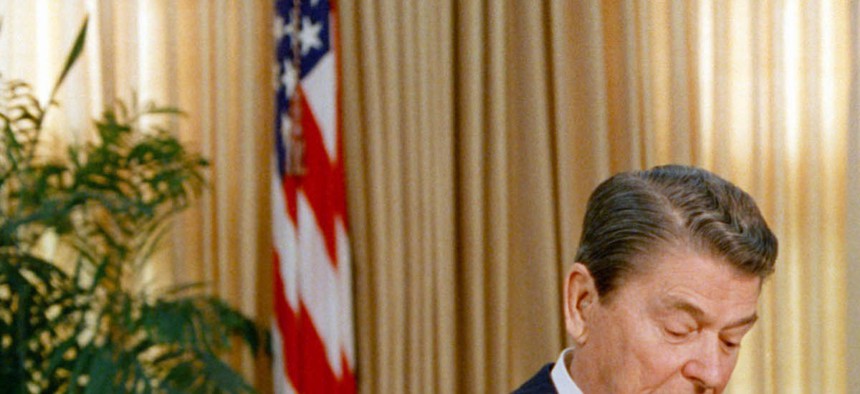
President Ronald Reagan checks his watch while talking to Soviet leader Mikhail Gorbachev in the White House. J. Scott Applewhite/AP
Why John Bolton’s Dangerous Call to Nuclear Arms Makes No Sense
John Bolton doesn’t know better than Ronald Reagan and Mikhail Gorbachev. By Joe Cirincione
Former Bush administration officials John Bolton and John Yoo want to respond to Russia’s Ukraine incursions by launching a new nuclear arms race. In their new Wall Street Journal op-ed they say that Russia’s recent violation of the Intermediate Nuclear Forces, or INF, treaty is good enough reason to trash the 27-year old agreement and build more nuclear weapons to deploy in Europe.
The agreement, negotiated between President Ronald Reagan and then-Soviet leader Mikhail Gorbachev, banned all ground-based short, medium and intermediate-range nuclear-armed missiles. These are missiles with between 500 and 5,500 kilometers range.
It has been one of the most successful arms control treaties in history, as I wrote in July for Defense One. It was the first to reduce, rather than limit, nuclear weapons. It sent 2,692 of these weapons to the recycling bin within a few short years, all but eliminated the possibility that the Soviets would be able to strike targets in Europe, North Africa, the Middle East, most of Asia or Alaska with nuclear weapons.
Bolton and Yoo want them back. We must build more nuclear weapons and base them in Europe and Asia, they insist, because “maintaining international security requires that the U.S. have access to the full spectrum of conventional and nuclear options.”
Never ones to waste a good crisis, Bolton and Yoo claim that Moscow’s “violations give America the opportunity to discard obsolete, Cold War-era limits on its own arsenal, and upgrade its military capabilities to match its global responsibilities...NATO can safeguard Europe and counter Russian intermediate-range missile deployments with air- and sea-based weapons of greater accuracy and similar payload…”
This may sound plausible, until you look a little closer.

“Releasing Russia from existing limits on strategic nuclear forces makes no sense,” Ploughshares Fund’s new policy director, Tom Collina, writes, “Especially at this time of severe tensions between the West and the Kremlin.”
We already have more weapons than we need. The United States has thousands of nuclear weapons ready to launch on 15-minutes notice. These nuclear monsters carry warheads 10 to 30 times more powerful than the bomb that destroyed Hiroshima. They can hit anywhere on Earth within an area the size of a football field 30 minutes after launch. There is no military requirement for more. In fact, the Joint Chiefs of Staff assess that we can cut our long-range weapons by one-third without any loss of military capability. Britain and France, of course, have their own nuclear arsenals.
Nor is there anywhere to base the new missiles. No government in Europe or Asia is calling for these weapons or offering to host them. The last time this was tried, during the U.S. and Soviet nuclear forces buildup of the 1980’s, millions of Europeans poured into the streets in protest. An effort to force-feed new nuclear weapons into Europe again would shatter the alliance and trigger a Russian nuclear build-up.
Nonetheless, Bolton and Yoo argue that Congress should “use its constitutional power over military spending to set the stage for American withdrawal from the INF [and] should fund new intermediate-range weapons systems.”
How exactly would we pay for this new multi-billion dollar program?
The Pentagon’s shrinking budget is already being devoured by two of the most expensive nuclear weapons systems in U.S. history: the Air Force’s Long Range Strike bomber and the Navy’s replacement for the Ohio class ballistic missile submarine.
Navy officials cannot figure out a way to pay for the new nuclear subs without slashing the conventional shipbuilding budget. Todd Harrison at the Center for Strategic and Budgetary Assessment writes, “While the budget picture appears sustainable for the next few years, [the] LRS-B and Ohio Replacement will begin to cost so much as the programs ramp up... that there just won’t be enough money to pay for it all.”

In other words, the Pentagon does not have the funds to pay for the existing nuclear weapons programs; additional weapons would hollow out conventional forces even further.
It is difficult to conceive of any military mission that requires the use of even one nuclear weapon. Indeed, in the 69 years since Hiroshima and Nagaski, dozens of wars involving nuclear powers have come and gone without a single atomic weapon being used.
Many military commanders agree with Colin Powell, former secretary of state and chairman of the joint chiefs of staff. “The one thing that I convinced myself after all these years of exposure to the use of nuclear weapons is that they were useless,” he said, “They could not be used.”
Sen. Dianne Feinstein, D-Calif., is one of several leading Congressional defense leaders who concur, “I agree with our nation’s military leaders—the U.S. has too many nuclear weapons and more can be done to reduce the size of our nuclear arsenal."
One reason is cost. The Congressional Budget Office estimates that current plans to maintain and modernize our nuclear arsenal and related programs over the next 10 years will cost at least $570 billion. Adding to that burden by depending more on weapons we do not need for a mission that does not exist would weaken U.S. national security just at the time withdrawing from the treaty would unleash a Russian arms build up.
Finally, for those who believe that some nuclear weapons in Europe make sense, the U.S. still keeps almost 200 air-dropped nuclear bombs in five European nations. This force had zero impact on Russia’s recent decisions. There is no evidence to suggest that a few hundred or a few thousand more would change Moscow’s calculus.
“Keeping nuclear weapons in Europe isn’t a coherent strategy, but rather represents a cobbling together of fragments of various strategies from the past,” notes Tom Nichols, professor of National Security Affairs at the Naval War College. “Without the overarching concepts of extended deterrence and mutual assured destruction in which they were embedded, tactical nuclear arms do not carry some kind of magical deterrent power merely by existing.”
Fortunately, few in Congress are responding to Bolton and Yoo’s call for “congressional conservatives [to] place the INF Treaty at the center of a campaign to restore America's strategic superiority.”
With good reason: it is a foolhardy and dangerous proposal for a return to a full-on nuclear arms race with Russia that would splinter NATO and crash the defense budget. Let’s hope this idea remains in orbit on the outer fringes of the national security debates.
Joe Cirincione is president of Ploughshares Fund and the author of Nuclear Nightmares: Securing the World Before It Is Too Late.
NEXT STORY: The US Needs a Third Missile Defense Site
